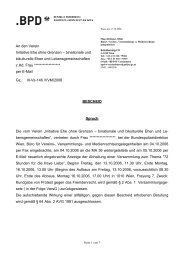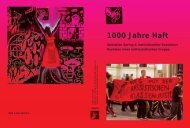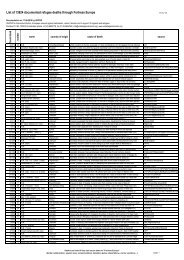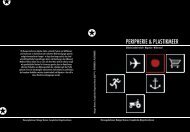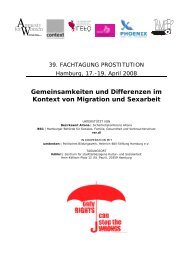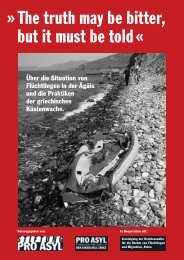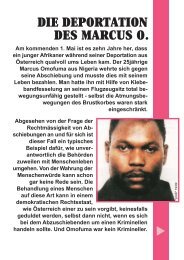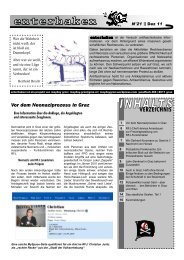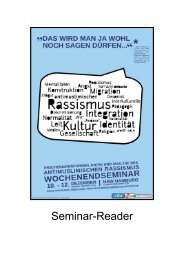Turin's CIE - International University College of Turin
Turin's CIE - International University College of Turin
Turin's CIE - International University College of Turin
You also want an ePaper? Increase the reach of your titles
YUMPU automatically turns print PDFs into web optimized ePapers that Google loves.
esearch group was able to interview a range <strong>of</strong> detainees from four <strong>of</strong> the five detention areas<br />
currently used inside <strong>CIE</strong> 8 , as well as from the seclusion area (the so-called Ospedaletto).<br />
The Sample Population<br />
Current and former detainees constituted the first group <strong>of</strong> interviewees (Interview Form n. 1).<br />
All current detainees were interviewed via telephone, and former detainees who had left <strong>Turin</strong><br />
after being released were also interviewed via telephone. The total number <strong>of</strong> current and<br />
former detainees interviewed was seventeen, with fifteen <strong>of</strong> them being inside <strong>CIE</strong> at the time<br />
when they undertook the interview. Three detainee interviewees were women and fourteen<br />
were men. The researchers’ decision not only to include but also to focus on interviews with<br />
detainees is based on the fact that it is extremely difficult to access information that<br />
encapsulates the lived experience <strong>of</strong> an Italian <strong>CIE</strong>. Feelings are individual and it is therefore<br />
impossible to paint a truly complete picture <strong>of</strong> how different detainees inside <strong>Turin</strong>’s <strong>CIE</strong> feel.<br />
Nevertheless, this report does strive to give voice to detainees and therefore it has involved<br />
substantially more first-hand detainee interviews than previous research studies on Italian<br />
<strong>CIE</strong>s.<br />
Whilst the most novel aspect <strong>of</strong> this report is the level <strong>of</strong> detainee participation, in order to<br />
make a balanced evaluation <strong>of</strong> <strong>Turin</strong>’s <strong>CIE</strong> it was also crucial to conduct long interviews with as<br />
many different parties as possible who have first-hand experience <strong>of</strong> the <strong>CIE</strong>. Consequently,<br />
Interview Form n. 2 was targeted to lawyers, religious personnel and NGO staff who enter<br />
<strong>Turin</strong>’s <strong>CIE</strong> on a regular basis or who used to enter <strong>CIE</strong> in the recent past. A similar albeit<br />
modified version <strong>of</strong> this form was used for journalists researching on the issue <strong>of</strong> immigration<br />
detention who had the chance to enter <strong>Turin</strong>’s <strong>CIE</strong> during the research timeframe. In total,<br />
twelve interviewees were part <strong>of</strong> this second group.<br />
According to the original research plan, a third group <strong>of</strong> subjects should have been included in<br />
the survey. This group would have been constituted by the <strong>CIE</strong> personnel, meaning people who<br />
manage or work inside the centre, namely the <strong>CIE</strong> director, Red Cross staff, military personnel,<br />
medical staff (doctors, nurses, psychologists) and social workers. Interview form n. 3 was<br />
drafted to conduct this last part <strong>of</strong> interviews and a formal request for authorisation to enter<br />
<strong>Turin</strong>’s <strong>CIE</strong>, interview its director/staff and access some figures was forwarded to the local<br />
authorities in May 2012 asking for a formal response by July 2012. Unfortunately we were not<br />
able to receive a formal response by July and we hope that this will be possible for our next<br />
investigation.<br />
Disclaimer<br />
As noted above, this report reflects the opinions <strong>of</strong> the individual researchers involved and it<br />
does not necessarily represent the opinions <strong>of</strong> either the <strong>International</strong> <strong>University</strong> <strong>College</strong> <strong>of</strong><br />
<strong>Turin</strong> or the partner institutions: Associazione Studi Giuridici sull’Immigrazione, the <strong>University</strong> <strong>of</strong><br />
<strong>Turin</strong> and the Eastern Piedmont <strong>University</strong>.<br />
This study involves a group <strong>of</strong> twenty-nine interviewees. Given the small sample group, there<br />
are naturally limits on the extent to which this research can draw wider systemic conclusions<br />
about the number or percentage <strong>of</strong> people who have similar experiences to our interviewees.<br />
However, this report has sought to overcome this barrier by conducting long interviews that<br />
give space for individual stories to be enunciated. Individual testimonies provide a poignant<br />
8 One <strong>of</strong> the six areas (the White Area) was closed in 2011 after a number <strong>of</strong> detainees escaped from this area.<br />
The detainees who were interviewed in this research project were detained in the Red, the Blue, the Green and<br />
the Violet areas. The only area the researchers were not able to access was the Yellow Area.<br />
13 | P a g e




